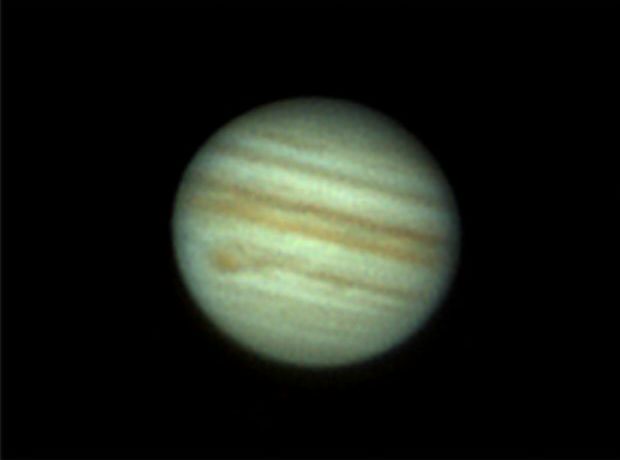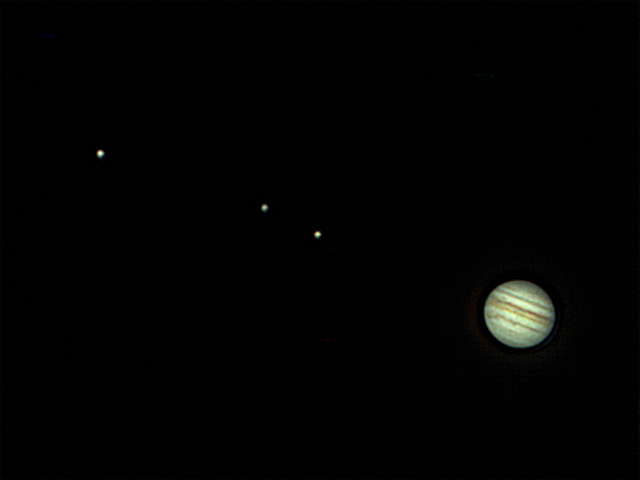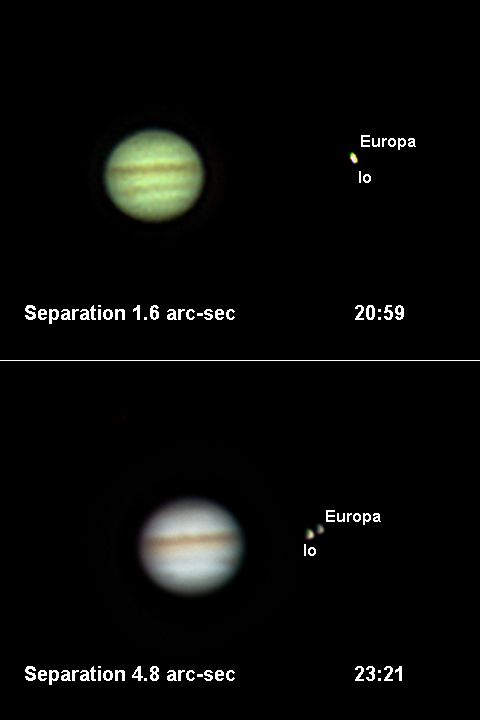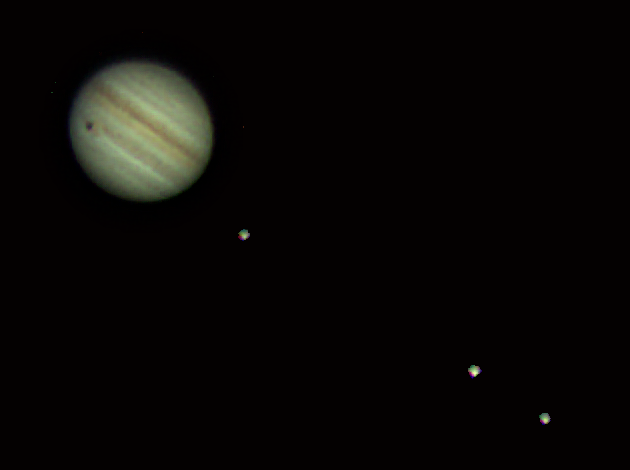

I have neglected Jupiter lately but I have been experimenting with a new way (for me) of processing my pictures.
This year the Earth is very close to the equatorial plane of Jupiter. This means that transits and shadow transits occur every revolution of the Galilean satellites and also that close encounters, or even occultations of two of them will occur. Sadly Jupiter is well south of the ecliptic and so is very low in our northern skies.
 |
Jupiter is still low in the skies this year and this picture was taken when it was 4° east of the meridian and at an altitude of only 24°. It was taken through my ETX125 telescope fitted with a ×2 teleadaptor lens giving a focal length of 3800 mm. During processing I used the drizzling technique in RegiStax to get a further enlargement of ×2. Date and Time: 17 July 2021 02:15 UT Telescope: ETX125 Camera: DFK 21AF04 Capture: IC Capture, 3600 frames, 1/91", gain 968 Processing: RegiStax 5, 3567 frames stacked with drizzle 0.5, colours realigned automatically, wavelets 1-4 = 30. Focus Magic 7, Gaussian blur 3 |
|
 |
And here is a smaller-scale image showing three of the Galilean satellites. Move your mouse pointer over the picture to see their names. Callisto was too far away to include in the picture. It is a composite of two exposures, one for the planet and a longer one for the satellites. Date and Time: 17 July 2021 01:46 and 01:49 Telescope: ETX125 Camera: DFK 21AF04 Exposure: 1/91 sec (planet), 1/8 sec (satellites), gain: 1023 Processed in Registax5: Planet 701 frames stacked, Wavelets 1-2 = 10. Focus Magic 4 Satellites 164 frames stacked, Wavelets 1-2 = 10. Focus Magic 4 |
|

|
On 27th August there was a close conjunction of Io and Europa. This is not a rare phenomenon since it will occur twice in each revolution of Europa which takes 3.55 days, but will occur this close whilst the Earth is close to the equatorial plane of Jupiter, which only occurs twice in each orbital period of Jupiter (nearly 12 years). Conditions were poor and got gradually worse as the night drew on. There was also a 2-hour period when I was unable to see Jupiter behind a neighbour's tree. Clouds finally put an end to the session. The radii of Io and Europa were 0.62 and 0.54 arc-seconds respectively, so that the gap between them at 20:59 was only about 0.44 arc-sec which is well within the Rayleigh limit of my telescope (0.7), so that is why I have failed to separate the two in the earlier picture. But at least you can see that there are two objects there. It is also interesting to see the amount that the two satellites have moved in the 2 hours 22 minutes between my pictures. Also they move in the same direction so Io must have been passing Europa at the time, and hence is the closer of the two objects. Date and Time: 27 August 2021 20:59 and 23:21 UT Telescope: 8-inch Ritchey-Chrétien Camera: DFK 21AF04 Exposure: 1/318 sec (planet), 1/19 sec (satellites), gain: 1023 Processed in Registax5: Wavelets 1-2 = 10. Focus Magic 4 Over-exposed image of Jupiter replaced with a correctly-exposed image in PhotoImpact. |
|
 |
(All the links here open in the same new window.) This is a shadow transit of Callisto. These are rarer events than for the other three Galilean satellites because Callisto takes so much longer to orbit the planet (17 days), and also because of its greater distance from Jupiter, which means it is more likely to pass either above or below the planet as seen from here. They will only occur when Jupiter is close to an equinox and its equatorial plane passes close to the Sun. Since this occurs roughly every six years, transits should occur in roughly that interval. I have an animation of a transit of Callisto taken in 2003 when the shadow passed almost centrally across the disc. So one might expect transits to occur in 2009, 2015, and 2021. I didn't image Jupiter at all in 2009 but did capture the other three satellites transiting in 2010. I just caught Callisto crossing the very north at the end of 2015 and a double transit of Io and Ganymede in 2014. Here you see the shadow tracking the GRS. The two move across the face at much the same pace so that the shadow will have kept pace with the GRS as Jupiter rotated. Sadly conditions were terrible and I was lucky to get these pictures. Jupiter is very low in the sky this year (unlike 18 years earlier when it was very high) and there was high cloud throughout. It actually set before the transit was over. Date and Time: 17 September 2021 22:59 and 23:19 UT Telescope: ETX125 at prime focus Camera: DFK 21AF04 Exposure: 1/38 sec (planet), 1/9 sec (satellites), gain: 1023 (Note the long exposures compared to the image above, indicative of the poor conditions.) Processed in Registax5: Wavelets 1-2 = 20. Focus Magic 7 The image of the planet was enlarged ×2 using drizzling, that of the satellites was enlarged in PhotoImpact before the over-exposed image of Jupiter was replaced with the correctly-exposed image. |
|